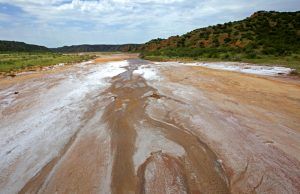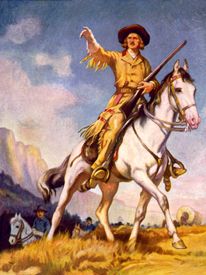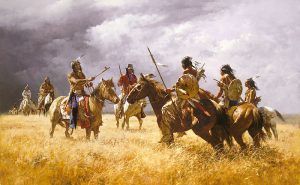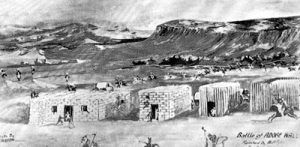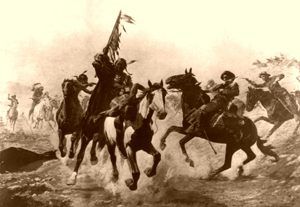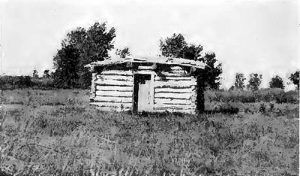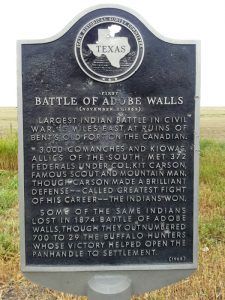Adobe Walls, Texas – Buffalo & Battles – Legends of America (original) (raw)
First Adobe Walls, Texas
Just north of the Canadian River, in what is now northeast Hutchinson County, Texas, is the site of Adobe Walls. This was the name given to a couple of trading posts and, later, a ranching community. The Bent, St. Vrain, and Company built the first trading post in about 1843. Comprised of William Bent and Ceran St. Vrain, the chief partners in the firm, and several traders, the company hoped to introduce peaceful trade with the Comanche and Kiowa tribes. The company’s main trading post, Bent’s Fort, was near present-day La Junta, Colorado. Still, the Comanche and Kiowa tribes avoided the area, as their enemies, the Cheyenne and Arapaho, lived in the region.
Red River in Texas
The new satellite post was on a stream known as Bent’s (now Bent) Creek. Here, company traders first worked from teepees and later from log structures. In September 1845, Lieutenant James W. Abert and his surveying party left the Canadian River to travel southeast toward the North Fork of the Red River.
Sometime around 1846, William Bent and Ceran St. Vrain arrived with Mexican adobe makers to replace the log establishment with Fort Adobe, a structure that was 80 feet square, with nine-foot walls and only one entrance. However, due to continued Indian hostility in the area, the occupation of Fort Adobe was sporadic, and in 1848 it was closed. That fall, a momentary peace was made with the Indians, and Bent sought to reopen the post by sending Christopher “Kit” Carson, Lucien Maxwell, and five employees to the Canadian River. However, the group encountered resistance from the Jicarilla Apache and were forced to hide the trade goods and buffalo robes they had acquired and returned to Bent’s Fort. A short time later, several members of the Comanche tribe persuaded William Bent to make another try at resuming trade at Fort Adobe. Bent agreed and soon sent a 13-man party led by Dick Wootton back to Fort Adobe. The group could finally conduct trade with the Comanche through a window cut in the wall.
Kit Carson
In the spring of 1849, Bent made a trip to Fort Adobe, accompanied by several ox-drawn wagons. However, after part of his stock was killed by hostile Indians, he had finally had enough. He soon blew up the fort, abandoning trade in the Texas Panhandle, and returned to Colorado. The ruins became a familiar landmark to anyone who ventured through the hostile country.
The expeditions of Randolph B. Marcy in 1849 and Amiel W. Whipple in 1853 traveled by Adobe Walls during their surveys of the Canadian River Valley.
First Battle of Adobe Walls (1864)
In 1864, Brigadier General James H. Carleton, commanding the Department of New Mexico, wanted to eliminate the Indian attacks on white settlers traveling along the Santa Fe Trail into New Mexico Territory. He soon sent Colonel Christopher “Kit” Carson, fresh from victories over the Apache and Navajo of New Mexico, to punish the Kiowa and Comanche for raiding along the trails.
Comanche Warriors
Leading 336 California and New Mexico Volunteers and 75 Ute and Jicarilla Apache auxiliaries, Carson led an attack against a nearby Kiowa village on November 25, 1864. Afterward, he and his men rested at the ruins of Adobe Walls. The next day, with the Comanche, the Kiowa counter-attacked Carson and his men at Adobe Walls. Though the Indians numbered over 1,000, Carson and his men could hold their position with two howitzers.
At dusk, the troops burned one of the camps and retreated to their base at Fort Bascom, New Mexico. Three of Carson’s men were killed, and 15 were wounded. Indian casualties totaled 60. Carson was acclaimed as a hero for fighting one of the most significant engagements on the Great Plains against far greater odds and minimal casualties.
Second Battle of Adobe Walls (1874)
Adobe Walls, Texas
A decade after the First Battle of Adobe Walls, several merchants from Dodge City, Kansas, following the buffalo hunters south into the Texas Panhandle, established a large complex called the Myers and Leonard Store near the Fort Adobe ruins. The business included a corral and restaurant, primarily serving the ever-increasing influx of buffalo hunters in the area. In April 1874, a second store was opened, operated by Charles Rath and Company. James N. Hanrahan and Charles Rath opened a saloon shortly afterward, and Tom O’Keefe started a blacksmith shop. By the end of spring, 200 to 300 buffalo hunters roamed the area, and trade at Adobe Walls was booming.
Of those Indians that remained in the area, they correctly perceived the post and the buffalo hunting as a significant threat to their existence. In the spring, the Indians held a Sun Dance, where Comanche medicine man Isa-tai foretold a victory to the warriors who fought to rid the buffalo hunters.
Early in the morning of June 27, 1874, a combined force of some 700 Comanche, Cheyenne, Kiowa, and Arapaho warriors, led by Comanche Chief Quanah Parker and Isa-tai, attacked the buffalo camp. The hunters took refuge in two stores and a saloon.
Though the post held only 28 men, including Old West characters Bat Masterson and Billy Dixon, Isa-tai’s prophecy proved an illusion. Despite being dramatically outnumbered, the hunters’ superior weapons repelled the Indian assault. Dixon, fighting from inside James Hanrahan’s saloon, is said to have made a historical shot, becoming a hero two days into the battle, when a bullet from his Sharps buffalo rifle knocked an Indian off his horse nearly a mile away, but this was perhaps exaggerated. Dixon himself never claimed credit for his “long shot.”
The Silenced Warwhoop by Charles Schreyvogel, 1908
After four days of continuous battle, about 100 men arrived to reinforce the post, and the Indians soon retreated. While estimates vary regarding the losses, as many as 70 Indians were killed, and many others, including Parker, were wounded.
The result of Adobe Walls was not only a crushing spiritual defeat for the Indians but also led to the Red River War of 1874-75 that would end in the final relocation of the Southern Plains Indians to reservations.
In August, during the Red River War, a detachment of troops under Lieutenant Francis “Frank” D. Baldwin fought off a party of 15 Indians near the beleaguered post, abandoned by October and later burned by the Indians. In 1876, Hutchinson County was established, and the area was opened to white settlement.
Settlement of Adobe Walls
Dixon Home near Adobe Walls, Texas
In the early 1880s, James M. Coburn established the Turkey Track Ranch, with his headquarters near the old battle site. He persuaded William “Billy” Dixon, a scout and survivor of the Second Battle of Adobe Walls, to homestead several sections nearby. Dixon built his house at the ruins of Fort Adobe. In August 1887, a post office was established at the Dixon homestead, where Dixon and business partner S. G. Carter also operated a ranch supply store. Dixon served as postmaster until 1901, when he was elected as Hutchinson County’s first sheriff. He resigned shortly afterward, disgusted at the political strife aroused in connection with the organization of the county. In 1902, Dixon moved to Plemons so that his children could attend school. Four years later, in 1906, he moved his family to the Oklahoma Panhandle.
William “Billy” Dixon
A school was established sometime in the early part of the 20th century. Documents note that Herbert Butts taught here in 1912 for $45 per month. The first school building burned down in about 1920, and school children then attended classes temporarily on the second floor of Billy Dixon’s old home on the Turkey Track Ranch. Later, another school was built. Although the Dodge City Times advertised Adobe Walls as “a fine settlement with some twenty families,” there never was a real community in the area even though it had a school and a post office, which served the area ranchers, their employees, and families. The post office remained in operation until October 1921.
During the 1920s, several local and state projects were launched to mark the battle site at Adobe Walls. In 1923, the Panhandle-Plains Historical Society acquired a six-acre tract that contained the remains of the 1874 trading post. On June 27, 1929, William “Billy” Dixon’s remains, which previously rested in the cemetery at Texline, were re-interred at the Adobe Walls site. In the 1970s, the society conducted significant archeological excavations at the site. In 1978, the complex was added to the National Register of Historic Places and recognized as a Texas state archeological landmark.
Adobe Walls Historic Marker
From 1940 until 1970, Adobe Walls was listed in the Texas Almanac as having a population of fifteen. Today, nothing is left of Adobe Walls but several markers, monuments, and the grave of William “Billy” Dixon. The Adobe Walls Springs, located west of the monument, are dried up today.
© Kathy Alexander/Legends of America, updated September 2023.

